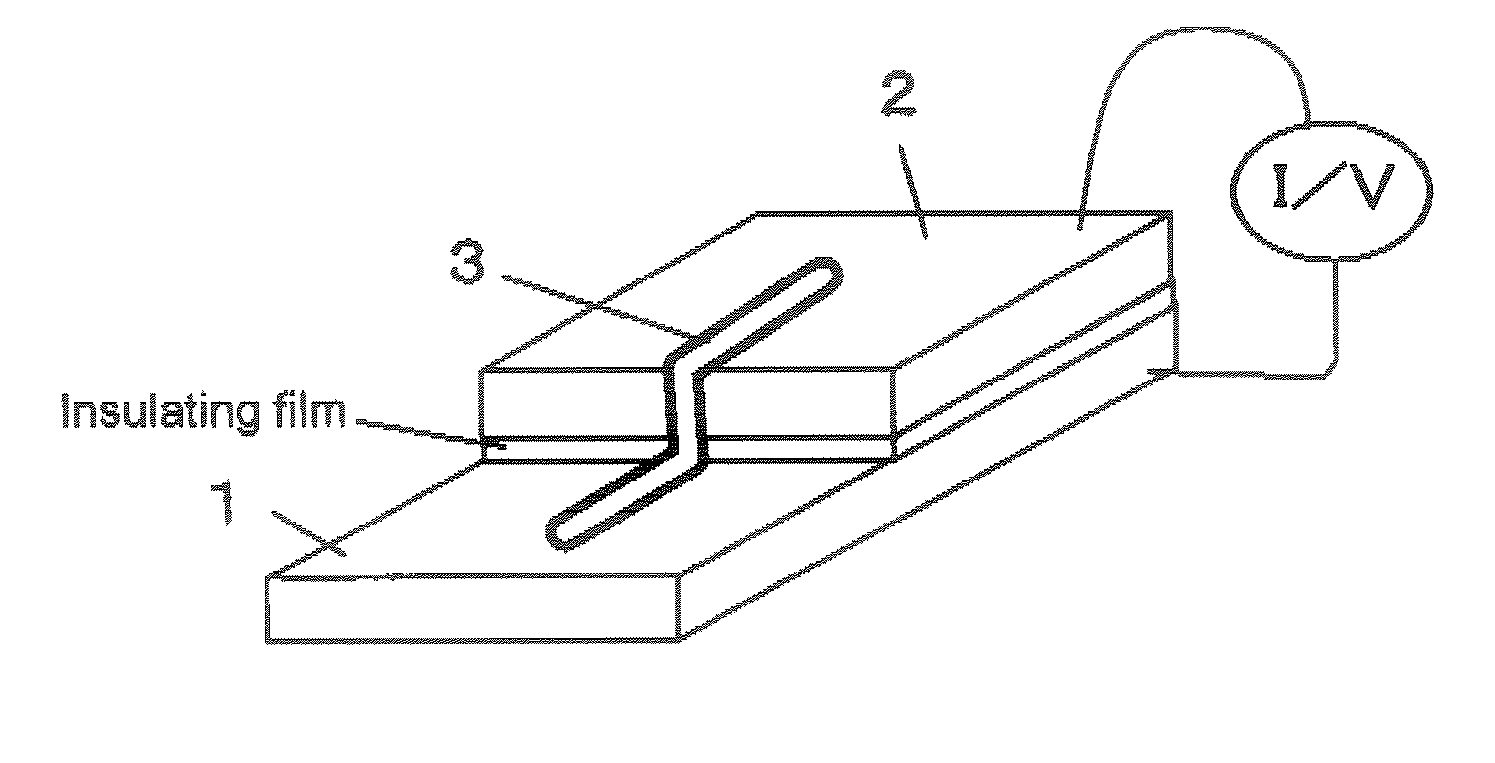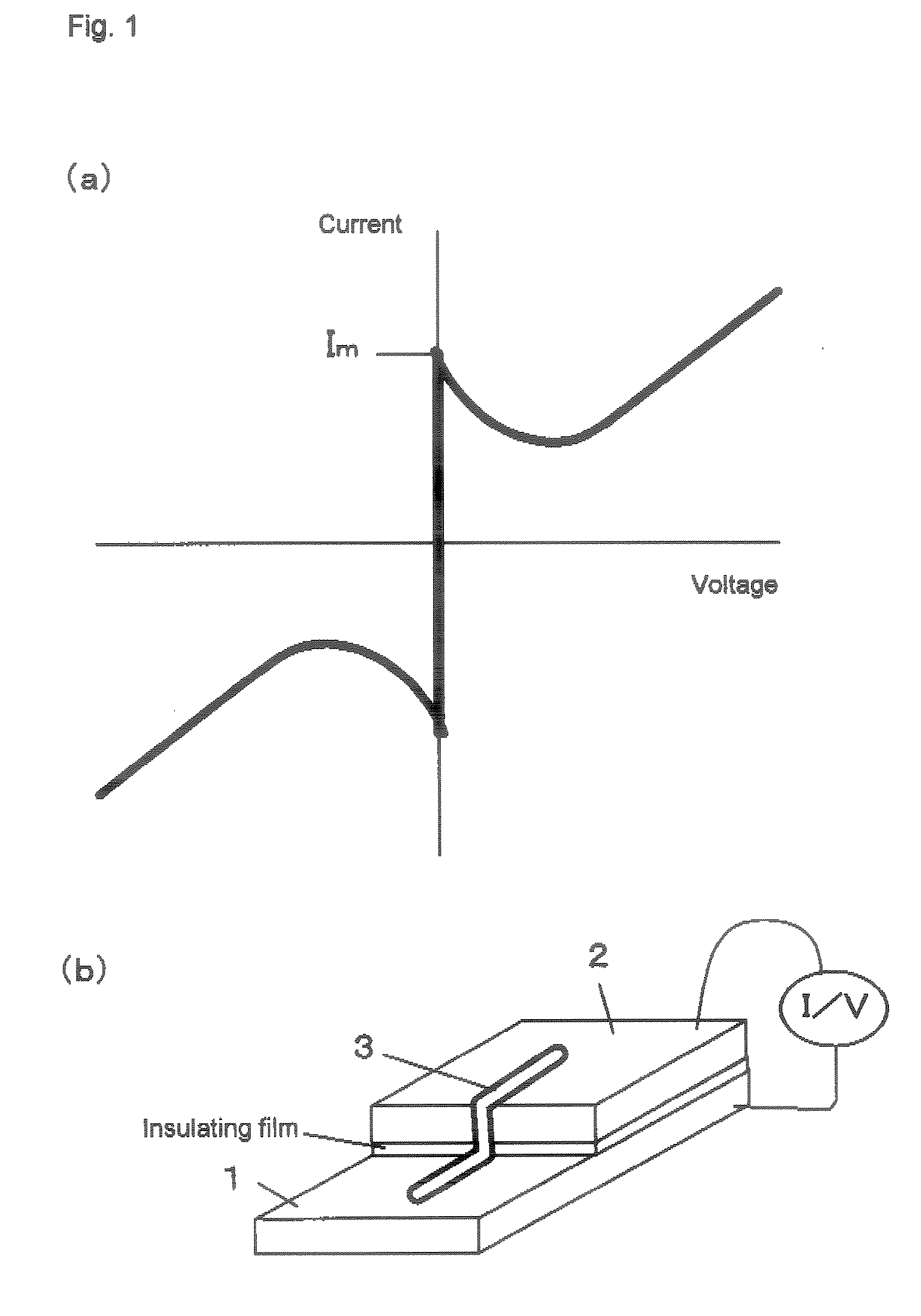Electromagnetic Wave Detecting Element and Electromagnetic Wave Detection Device Using the Same
a technology of electromagnetic wave detection and electromagnetic wave, applied in the field of electromagnetic wave detection, can solve the problems of difficulty in deriving current transport property, uniform distribution, and difficulty in operation as a whole, and achieve the effects of simplifying the fabrication process, high sensitivity, and simplifying the devi
- Summary
- Abstract
- Description
- Claims
- Application Information
AI Technical Summary
Benefits of technology
Problems solved by technology
Method used
Image
Examples
embodiment 1
[0037] An example of the process adopted for the formation of an electromagnetic wave detection element of this invention will be shown below.
[0038] (1) On a substrate having an oxide film formed by thermal oxidation or deposition on the surface of a flat substrates such as a silicon substrate, films of a superconductor 1 made of niobium, niobium nitride, MgB2 or an oxide-based superconducting material are formed in a film thickness of 100 nm in an arrangement illustrated in FIG. 5 and are patterned by the ordinary lithography technique. This thickness nay vary in the range of 50 nm to 300 nm. Since the superconductor 1 is fated to become a first electrode during the patterning process, the size thereof prefers to be such that the upper limit thereof will be contained in a circle having a radius of not more than 5 times the wavelength of an electromagnetic wave to be detected and the lower limit of the whole size embracing electromagnetic waves and particle rays having a higher ene...
embodiment 2
[0050]FIG. 8 illustrates the positions of bias voltage occurring during the detection of an electromagnetic wave by the use of an electromagnetic detection element 10. When the bias voltage is set at such positions of small voltage as approximates closely to zero in the negative resistance region as illustrated in the drawing, the electric current is varied with high sensitivity as indicated by the dotted line / solid line of FIG. 8 by the on / off of the radiation of the electromagnetic wave. By enabling the voltage bias condition dilated to not less than several times to be secured by the series connection, it is rendered possible to implement practical bias setting and accomplish detection of an electromagnetic wave with high sensitivity.
[0051] When the frequency of the electromagnetic wave subjected to detection exceeds the energy gap between the first and second superconducting electrodes, the electromagnetic wave detection element consequently obtained can be made to utilize effe...
embodiment 3
[0056]FIG. 9 is a block diagram depicting the case of configuring a detecting cell 20 using the electromagnetic detection elements 10. A bias voltage in the negative resistance region is applied as illustrated in FIG. 8 to the electromagnetic detection element 10 via a bias circuit 21 and the change in the electric current is detected by a sense amplifier 23 as transformed by a load 22 into a change in voltage. The output of the sense amplifier 23 is transmitted to a signal line via a switching circuit that is controlled with a signal for row address designation.
[0057] The structure that results from arraying the detecting cells 20 of FIG. 9 in the shape of a matrix is illustrated in FIG. 10. FIG. 10 represent a matrix of 3×3. It is evident that the structure of 3×1 enables implementing one-dimensional detection. It is also evident that the resolution during the course of detection can be enhanced by adding to the number of detecting cells 20 within a fixed surface area owing to th...
PUM
 Login to View More
Login to View More Abstract
Description
Claims
Application Information
 Login to View More
Login to View More - R&D
- Intellectual Property
- Life Sciences
- Materials
- Tech Scout
- Unparalleled Data Quality
- Higher Quality Content
- 60% Fewer Hallucinations
Browse by: Latest US Patents, China's latest patents, Technical Efficacy Thesaurus, Application Domain, Technology Topic, Popular Technical Reports.
© 2025 PatSnap. All rights reserved.Legal|Privacy policy|Modern Slavery Act Transparency Statement|Sitemap|About US| Contact US: help@patsnap.com



